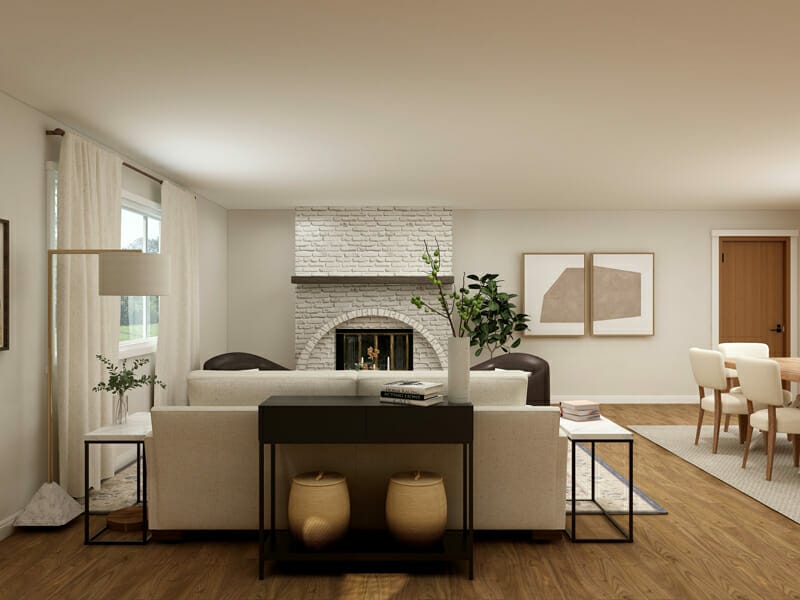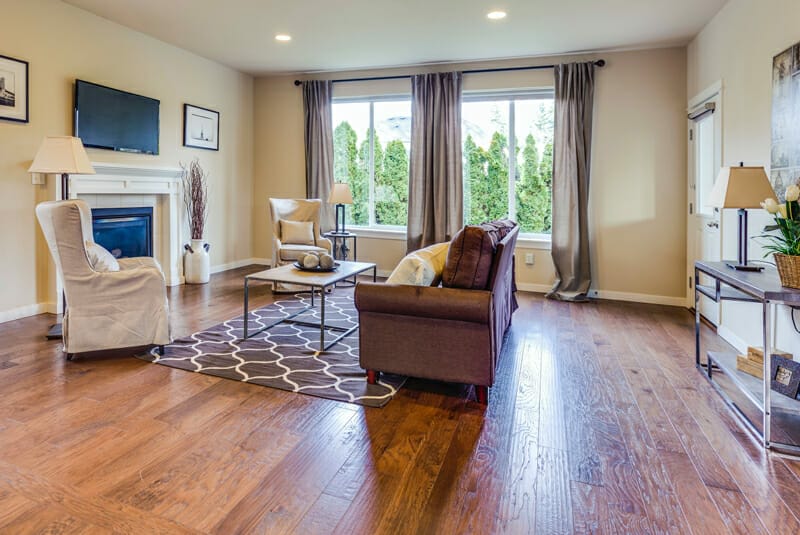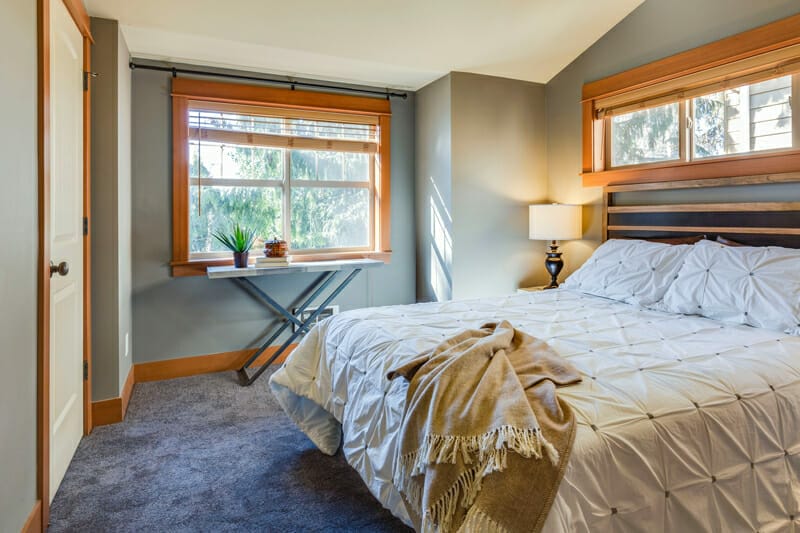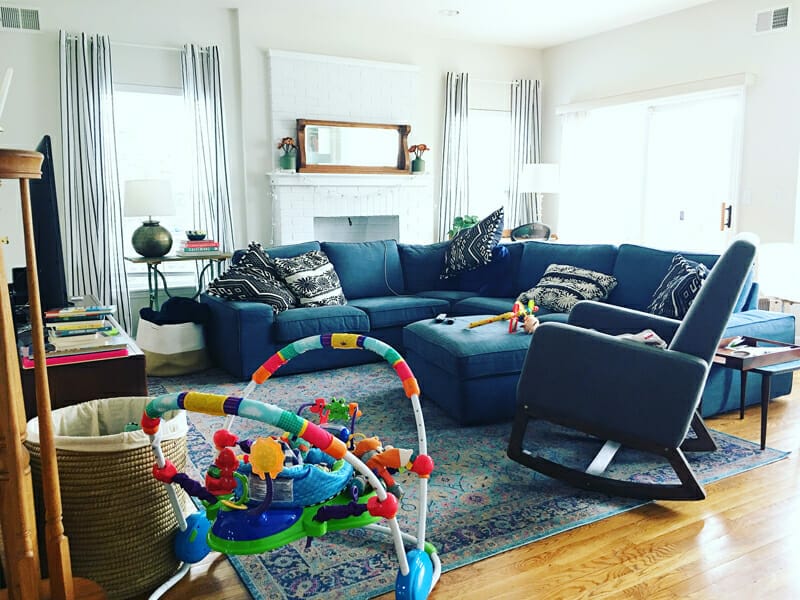My first house was a tiny rental a few feet away from a college campus. It was a tiny 1920’s cottage and had a kitchen swathed in 1970’s mushroom wallpaper. I loved it. However, after I moved in, I quickly realized there was a major fly in the ointment. The living room had only one usable wall.
The answer lay in floating the couch between the living room and the dining area. I had never contemplated having a sofa in the middle of a room, but it worked. As the years have passed, I’ve run up against some odd spaces, and it usually took me a year of moving furniture around to find the perfect solution. But, no matter the oddities of a space, there’s a key for every lock in arranging furniture.

Orient Furniture Around a Focal Point
Ideally, there’s a focal point in your room. Whether it’s a fireplace or a TV, there’s usually one point of focus that your eye gravitates toward. Most designers ascribe to the “TVs should go over the fireplace, and if possible make it not look like a TV” philosophy. But I’m not a designer (clearly), and I think it’s fine if the room revolves around the TV. If you can’t put your TV above the fireplace, don’t sweat it too much. After all, we’re not all spending hours staring into the fireplace after work. We’re sitting with our feet propped up and watching reruns of The Office. Whether we like it or not, TV’s rule is supreme, and it’s perfectly fine to stop fighting it.

Float Furniture
There is no rule that all your furniture needs to be wedged against a wall. Sofas, sectionals, side tables and chairs all have a pass to “create” a room without being relegated to wall space. Some rooms, especially given our modern penchant for open floor plans, just don’t lend themselves to wall-dwelling furniture, and in order to create a cozy seating/living space, arrange furniture to float around the TV, wall, or fireplace.

Make Room for Traffic
No matter how visually pleasing a room is, no matter how well coordinated its fabrics are, no matter how expensive an area rug it possesses, these things are for naught if you and your family routinely kick your shins and toes on an obtrusive coffee table or a sofa that’s placed directly in the line of traffic to the kitchen. Just as animals in the wild travel the paths of least resistance to water sources and shelter, we humans aren’t that different in our need to get popcorn from the pantry or run quickly for the bathroom when we’ve consumed way too many Diet Cokes. Consider arranging furniture so the humans in your domain can still walk (or run) across the room without risking mortal peril.

Never Block a Window
When faced with a lack of wall space, some homeowners lose their patience. And in doing so, they sometimes make poor decisions, like blocking windows or return vents with tall furniture, like bookcases. Does that sound specific? It should because the previous homeowners in my home did that exact thing. You don’t even want to know the level of dirt build-up in that return vent. The lesson? You may have to be okay with giving up massive pieces of furniture if it’s a choice between them and blocking a window.

Go Ahead and Put That Bed in Front of the Window
Wait? Didn’t I just say don’t ever block a window? Well, this is a caveat and not quite the same. As long as your bed and headboard are low profile and fit under (or barely above) a window, it’s fine. Your bed should ideally be centered on the longest wall in the bedroom, so don’t worry if a window happens to be on said wall.

Switch Rooms
Is your living room awkward? Does your dining room have a better flow and more wall space for furniture? Don’t be afraid to switch rooms to tackle tricky furniture arrangement conundrums. A friend of mine lived in an older home, and she switched her dining room to the front living room area. You walked into a beautiful dining room, complete with a hall tree to one side and a crackling fireplace on the other. It served as a formal dining room and a sizable entry and space for work projects. The original dining room was converted to the living area. It worked nicely as it had better lighting, better flow, and more wall space to place furniture (not to mention closer proximity to the kitchen, which worked well since the family ate most of their meals on the sofa)

Sometimes Just Throw All the Rules Out the Window
In my last home, I violated two design rules. 1. Make your fireplace the focal point. 2. Don’t put the back of your sofa against said fireplace. But here was my reasoning; I had a less-than-year-old baby, and I decided to do what I wanted. The fireplace wasn’t functioning, and the mantle was far too high for a tv (the wall also lacked the electrical components to make that happen). Turning my sectional to face the fireplace also completely blocked off normal traffic flows across the room to the basement door. So, I did this. I blocked the fireplace and faced everything toward the tv wall. I was tired. It kept my baby out of the fireplace (note the child’s accoutrement scattered about). It worked.
At the end of the day, it’s your home. There are certain furniture arrangement rules/solutions that exist, like the ones in this article. But they should be designed to make your home more functional and allow you and your family to be more comfortable living your lives inside it. So, if you need to float a couch, do it. If you need your couch to block the fireplace so your toddler doesn’t hurt himself, do that, too. Arranging furniture to suit your room (and life) is tricky, but never impossible.


